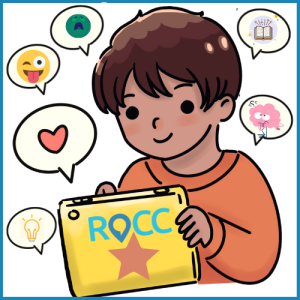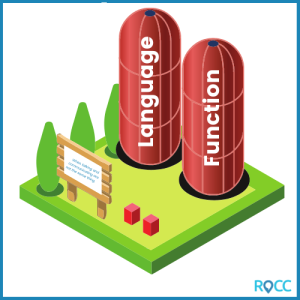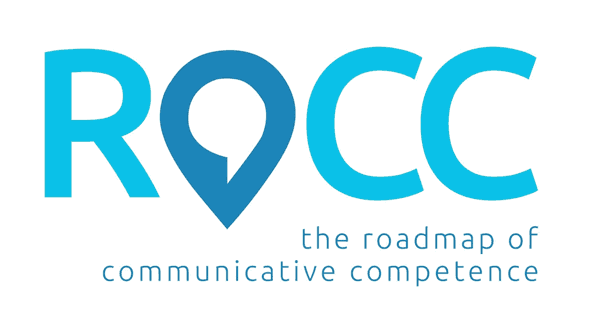
Our next featured domain discussion is around Domain #7, RANGE OF FUNCTIONS
The goal: To communicate for a range of intentions (including but not limited to: commenting, questioning, sharing information, expressing opinions, joking, etc).
This domain aims to draw attention to the range of communicative (or pragmatic) functions used by the participant. These are the many reasons they communicate with others.
Individuals may use their words, signs, symbols, gestures or body language for a range of purposes, and in order to become competent communicators, we need to expand our range of functions as well as the words we use to express them (domain 6). As you will hear many people saying, ‘communication is more than just requesting’.
The ROCC manual (which you can download from your ROCC subscription login (click on Help and Resources), gives the following definition.
Range of intentions / Conversational intents – Intentions mean the reason for the message. For example, this would refer to some of the following ‘intents’ – gaining attention, requesting, commenting, complaining, sharing information, asking questions, and others. A range of intentions is often referred to in goals for an individual, or in a requirement of a comprehensive communication system. Natural and successful conversation and interaction includes a range of intentions.
Why is this domain important?
In the early stages of communication development, individuals often rely on others to interpret the purpose of their message.
Partners may:
- see them look upset to interpret that they are complaining,
- show excitement to request recurrence (“more”), or
- reach, look or move toward something to ask for it.
However at this stage (level 0 – domain 7), the partner cannot be 100% sure that they are interpreting the exact intent of the message.
As the individual begins to be able to make choices, or answer questions (level 1 – domain 7), partners can gain some clarity on their preferences within a limited set of options, but are still not gaining full access (through language) to the true messages that they are thinking. In these situations, there is a reliance on the communication partner to set the intent (ie. offering options to request, or asking a question to get a response) rather than the message originating with the individual.
Since some of the main reasons that we communicate are for enjoyment, social closeness and sharing, individuals need to move beyond choice making and answering questions to take advantage of the wide range of benefits that communicative competence can allow them.
At first, they may just initiate requests or simple messages themselves (level 2 – domain 7). These are motivating messages to learn and there is often a fairly immediate or concrete response. An individual might ask for their favourite things, or tell us “more, “finished”, or “help”. They often learn greetings at these early stages also. ‘Hellos and goodbyes’ are motivating messages that usually occur frequently and naturally throughout the day. Most greetings are also easily conveyed with gesture, eye contact, facial expression or body language, rather than symbolic communication, and so tend to develop earlier than some of the other functions.
In the early stages, many communication partners focus on making sure the individual can ask for what they need, or tell others what is wrong, but it’s also important to help them learn to comment on things they like and complain about things they don’t like (level 3 – domain 7). Through these early developing functions, we can begin to express our personality, preference and gain control over our environment. If we share that we like something, we tend to get more opportunities to experience it or learn more about it. As we share opinions with others, we find similarities and differences that build relationships, or give us a sense of self and belonging.
As our language competency develops (levels 3, 4 and 5 in domain 6), we can start to share information and ask questions as well. As we learn to combine words into phrases and sentences, we can talk about events and activities from the past or in the future. We can also convey more specific meaning that enables more complex functions such as joking, manipulating, bargaining, sharing narratives or directing others to do things (moving up to level 4 and 5 in domain 7). All of these functions enable our autonomy and self determination as we learn to use language for its varied purposes.
It is important to distinguish between the function of the message as opposed to the actual words, signs or symbols used. However, development of language complexity (domain 6) is often reliant on an increase in domain 7, and vice versa. Though complex language is not required to communicate a range of functions (e.g. “go away” is often clearly expressed with gesture or body language), more complex language often enables the individual to autonomously express themself rather than rely on others to interpret the meaning of their message. For example, if an individual says “biscuit” without any additional intonation or contextual cues, we usually think they mean that they want a biscuit, rather than other things they might be thinking like:
- That was a yucky biscuit. (comment/complain)
- My mum made biscuits last night. (sharing information)
- He threw a biscuit. (sharing information)
- I love biscuits. (comment)
- Do you have any biscuits today? (question)
- Where is the biscuit? (question)
- That’s a biscuit. (naming)
- And many more.
For this reason, progression through domain 7 is important for the development of communicative competence. As communication partners, we need to enable individuals to move beyond just asking us for things, or telling us answers to the questions we ask them. We should aim for them to communicate the things that they want to tell us.
It is tempting to focus on naming and requesting things in the early stages as these are easy words and functions to teach, but if we watch closely, we will see other functions of communication emerging through gesture and body language. Unless we map language onto those functions (speech, sign or symbols), we will end up with 2 silos, one that is language and the other that is function.

When this happens, we often see individuals learn to say, sign or speak words to answer our questions, or label things, but then use their body language and gestures as their primary mode of communication for interaction. Being mindful of the importance of development within domain 7 can help us to avoid these silos (see ‘What can I do’ below for strategy ideas).
Scoring notes
This domain is a very general measure of the range of functions that individuals may use to express their autonomous thoughts. They may not always progress in the order listed in this domain, and other functions may be present in one situation but not necessarily across all settings or partners.
Remember that the ROCC is a guideline or roadmap toward communicative competence and aims to give a general profile of competence. The idea is to select the level that best represents the individual’s communication. You will note the scoring for this domain suggests: If use of a particular function is only just emerging, or is used for one common utterance only, then consider scoring at the level below until it is used more consistently and across a wider range of messages.
It is beyond the scope of the ROCC to review pragmatic development in detail, and so it recommends a more detailed look at pragmatics, particularly if the individual is scoring at levels 2 and above. This is recommended particularly if this domain appears to be the one that is having the biggest impact on the individual’s communicative competence. The ROCC online provides links to some assessments that may be used to gain more information. A more detailed look at pragmatic functions may highlight areas that an individual is able to convey an intention using their body language but not yet more specifically with symbolic language. This information can inform the types of words we model for individuals to learn to express these functions in words as their language develops.
What can I do?
One of the first steps to facilitating progress within this domain is awareness. As you score domain 7, and any more detailed assessments related to pragmatic functions, you will notice whether the individual is using their system for a range of interactional intents, or not. Often they may only use it when asked to make a choice or answer a question and in this instance it might be helpful to review strategies around domains 3 and 5 to ensure that they see the system as a means of conveying autonomous messages in the first place.
Another way to enable development in this domain is to really focus on modelling language within natural interactions and throughout the day. Think about interactions with a range of communication partners including peers or siblings. When someone is at the early stages of language development (using any mode), it is often tempting to ask lots of questions to ‘check on’ their learning, or give them choices to make things easier for them. However, if we model language in a natural and interactive way, most of the functions will pop up as both:
- ‘their talk’ (where we are modelling what they might be trying to tell us) or
- ‘our talk’ (where we model the things we are saying to them).
Another important strategy is to suggest rather than guess. If an individual says only one or two words, don’t assume you know what they mean. Maybe you could suggest by expanding on their message rather than just assuming.
In the biscuit example we could say something like:
- Maybe you are saying “biscuit please” or “I don’t like that biscuit – it’s yucky” or “where is the biscuit?” (modelling the underlined words for those at a single word level)
There are many more ways you can expand on the range of communicative functions that a person can express once you know where you are headed by reviewing the next level up on the ROCC for your person. In addition, consult with a speech pathologist, or take a look at some of our links below for more ideas.
Useful links on this topic:
ROCC FAQs especially:
- How-is-the-rocc-different-to-the-pragmatics-profile-or-the-communication-matrix-both-of-which-are-cost-free/
- What-are-the-key-differences-between-emergent-transitional-and-competent-communicators
ROCC Blogs – Particularly A closer look at ROCC Domain 6 to consider the language level of the individual and how that relates to or impacts on their range of functions.
TWS EXPAND program – especially for those scoring at levels 0-3
TWS Emerging communicators – especially for those scoring at levels 0-2
You can also learn more about Domain 7 in the context of ROCC by doing the ROCC Basic Training
To find out more about Domain 7 or any other Domain, get in touch with us at rocc@roccassessment.com.au
